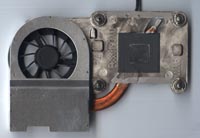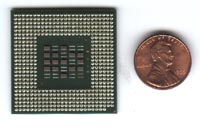WinBook N4 Pentium 4-M 1.8GHz Notebook
by Matthew Witheiler on April 23, 2002 5:45 AM EST- Posted in
- Laptops
Construction - Under the Hood
The WinBook N4 that we received ranks as one of the more powerful desktop replacement notebooks to date. The system was anything but slow, outfitted with a 1.8GHz Mobile Pentium 4-M processor, 512MB DDR memory, a 40GB hard drive, an internal DVD/CD-RW drive and an internal floppy drive.
One of the most impressive aspects of the N4 is it's processor. The 1.8GHz Mobile Pentium 4-M is the fastest Mobile Pentium 4-M to date. Unlike the Toshiba Satellite 1905-S277, the N4 uses the mobile version of the Pentium 4 which offers a few advanced features not available on the desktop Pentium 4 chips.
The Mobile Pentium 4-M is based on the Northwood core, meaning that it is manufactured on a 0.13 micron process and features 512KB of integrated L2 cache. The chip also features Intel's SpeedStep technology which has changed a bit from its last incarnation in the Mobile Pentium III chips. Previous Pentium chips with SpeedStep changed their clock speed depending on the power status of the system. When the notebook was running off of AC power , the CPU would clock itself at the standard clock speed. When the system detected that the system was switched from AC to battery power, the CPU would underclock itself to the SpeedStep speed. For example, the ASUS T9 that we looked at a few weeks ago uses a Mobile Pentium III chip that clocked itself at 900MHz when running on AC power and 700MHz when running on battery power. Intel's latest SpeedStep technology changed this a bit.
Now, instead of determining clock speed based on power source, Mobile Pentium 4-M chips clock themselves based on CPU demand. For example, our 1.8GHz Mobile Pentium 4-M also had the ability to dynamically underclock itself to 1.2GHz (a 12x multiplier) based on how much the CPU was doing. When on AC power and sitting idle or typing in a word processor, the N4 clocked itself down to 1.2GHz as the CPU was not being used a whole lot. As soon as another intensive operation was performed, however, system speed jumped back up to 1.8GHz. The same situation exists while running under battery power: while performing nonstressful tasks, the system clocked down to 1.2GHz but clocked itself back to 1.8GHz as soon as moderate CPU usage was detected.
This provides a perfect balance between battery life an performance, building off the idea of "hurry up and get idle." Not only does this make sense from a power conservation perspective but it also makes logical sense from a user's perspective. When we work, we are not concerned with how fast our key strokes are processed in Word but rather with how fast complex operations occur such as opening programs and editing images. SpeedStep technology is moving closer to where it should be ideally, where the system dynamically clocks itself through a full range of speeds depending on needs. The change from the old SpeedStep to the new one is a big move in the right direction.
The 1.8GHz Mobile Pentium 4-M in the N4 is far from user upgradable. The chip lies in the heart of the system and requires quite a bit of disassembly to get to. Cooling for the chip is provided by a fairly large copper heatsink bonded to the exposed core of the Mobile Pentium 4-M by a thermal pad. Airflow across the heatsink's fins is provided by a fan mounted to the left of the chip. Heat from the core of the CPU is transferred to the heatsink surface via a thermal pipe.
Once the heatsink was removed, the Mobile Pentium 4-M chip was revealed. Unlike desktop Pentium 4's, the Mobile Pentium 4-M chips do not have an integrated heatspreader, likely for space reasons. This left the flip chip design of the Mobile Pentium 4-M exposed. The processor in the N4 is socketed and found its home in Molex style socket that allowed for easy removal with the twist of a screw.
In order to use the Mobile Pentium 4-M CPU, WinBook also had to make use of the new 845MP chipset. Produced for the mobile market, the 845MP is essentially the mobile version of the DDR 845 motherboard. The chipset supports SpeedStep technology and also offers a 400MHz processor bus speed, a 200MHz or 266MHz DDR memory bus speed, and support for external AGP 4X graphics. Both the north bridge and the south bridge of the 845MP are located on the bottom of the N4's motherboard, with the northbridge being cooled by the small fan mounted on the back of the notebook.
Although the 845MP supports a 266MHz memory bus speed, the N4's memory bus runs at 200MHz.














0 Comments
View All Comments